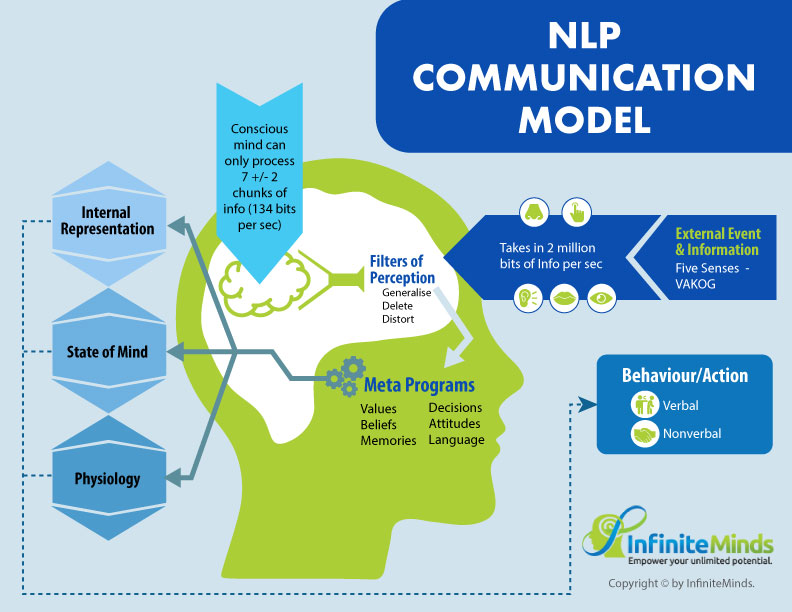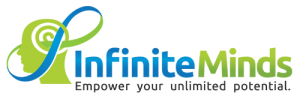NLP is about paying attention to the communication on both the outside and inside. To how our mind works and how it impacts on our communication and behaviours. thoughts and words.
The NLP Communication Model is taken from the work of John Grinder and Richard Bandler, and developed by Tad James & Wyatt Woodsmall. The model explains how we take in information from our external environment and how this impacts our thoughts, feelings and behaviours, how we interact and communicate with our environment, other people and ourselves.
It draws on Cognitive Psychology and also linguistic analysis. The model demonstrates how we interact and communicate with our environment, other people and ourselves which then becomes a representation of our individual perception of reality.

The external environment constantly bombards us with complex information which we process through our fives senses ie our Visual, Auditory, Kinesthic, Olfactory and Gustatory, (VAKOG). People sometimes have a strong preference for one sense. They may prefer to see or hear something to understand it, whilst others prefer to get a feeling for something. Some people use a combination of their senses without a dominance of one or another sense.
Our mind is able to take in 2.4 millions bits of information per second (there is some discussion that it may be more than this amount) however our conscious mind is only able to process 134 bits per second.) This means that most of the information that our mind takes in is absorbed and assimilated unconsciously.
Our mind has a set of Perceptual Filters which Generalise, Delete or Distort information received from our five senses into more manageable information which then flows through a complex selection process involving a set of Meta Programs (thinking patterns), our Values, Beliefs, Memories, Decisions, Attitudes and languages, which in turn are also influenced by our cultural backgrounds.
The filters are our unique way that we make decisions and use patterns to interpret our complex world.
Perceptual Filers or what is known as the “NLP Universal Modeling Process”
Once we take in stimuli or information through our five senses we then begin to delete, distort or generalise:
∞ Delete: we selectively pay attention to particular things in our experience and ignore other aspects. We are able to focus on what we determine to be most important at at a specific moment and delete the rest from our conscious awareness.
 ∞ Distortion: we misrepresent reality by making changes or shifts in our experience of the information from our senses. We can use distortion to motivate ourselves when we change or distort the material coming into our brain’s neurology. This may include procrastination, being frightened by something harmless or misinterpreting what may be said by a person.
∞ Distortion: we misrepresent reality by making changes or shifts in our experience of the information from our senses. We can use distortion to motivate ourselves when we change or distort the material coming into our brain’s neurology. This may include procrastination, being frightened by something harmless or misinterpreting what may be said by a person.
∞ Generalisation: we oversimplify new or current material based on our previous experiences. It is a useful filter when we need to complete a task because we are able to apply generalisation to learn about specific information. We may also have an opinion about something and then we make broad conclusions based on that prior experience. Generalisation also occurs when we oversimplify and make decisions based on insufficient information.
Stereotyping is a classic example of when people make broad assumptions and filter out new information based on their previous attitudes & decisions. Generalisation is useful when we have to make choices or decisions quickly and it is understandable that we do so based on our past knowledge & experience. We believe that in some ways Generalisation can be compared to our Intuition, but that’s another story.

Our next level of processing external stimuli is using our Meta Programs which is one of our most subconscious filters. Meta programs are seen to be like a “Blue print” which we from birth and is thought to include personality types, however we now know that these are malleable.
Our Values then decide what is important, right or wrong for us and are used as a beacon to guide our behaviour. Values are changeable over time, they can be complex or simple and variable depending upon the context.
Check out our Values which generally guide our lives, how we relate and work with our clients.
Our Beliefs are our generalisations about the HOW of the world. It is our belief system which will gives us or take away our power because it can have limit or encourage a person. It is our Belief System, often developed in our younger years, which hold the power to move a person forward or to hold them back, remaining stuck and resistant to change.
 Memories are very fluid and may be influenced by time. Psychological and Neuroscience studies indicate that our memory is a reconstructive process that is susceptible to distortion.
Memories are very fluid and may be influenced by time. Psychological and Neuroscience studies indicate that our memory is a reconstructive process that is susceptible to distortion.
Memories may not be historically reliable and can be the source of considerable pain in a person’s life.
When positive or not so positive feelings, are attached to particular memories they can be carried forward for many years and may also be triggered by particular events.
Decisions are an important part of our filtering system because they may have been created sometime ago and we may just accept them rather than reconsider their relevance in our life of today. When decisions are revisited, they can create new beliefs which may lead to significant positive changes in your life. If you do not review your old decisions then they will continue to influence how you respond to current situations – both good or bad.
Attitudes are formed when you string together a number of thoughts and feelings which become habitual or automatic. How you think and feel can create a state of being, which changes from moment to moment depending on how you alter how you think and feel. It is when people maintain a particular ättitude” that it is likely to become a “belief” ie at that stage it is likely that you have attached a particular emotion to your thoughts & feelings, which in turn this attitude has hardwired into our brain as a “belief”.
Language are the words, visually and kinaesthetic which we use to represent and describe our thoughts, feelings, emotions, beliefs. This includes our understanding of words and gestures.
Internal Representation, State of Mind and Physiology
This in turn is influenced by how we make an internal representation of the event, our emotional state or mood and also our physiology at that particular time. Once the incoming information is processed by our unique Filters, a thought will be constructed which in turn make up our internal representations ie our World Map or own Reality.

It is our Internal representations that become sensory perceptions, such as emotional feelings, tastes etc which then trigger particular states, that will in turn motivate our behaviour.
If you are feeling angry, fearful, sad, content, happy, relaxed or in pain at a particular moment then this will impact differently on how you perceive the same event or a possible trigger. This in turn impacts our physiology.
Some people tend to have a fairly stable state whilst other people tend to be influenced to a greater extent by their environment. You may know people that can be described as a “Happy, Miserable, Enthusiastic or Competitive” person because they seem to have that general type of personality, which tends to be self perpetuating after a period of time.
The NLP Communication process explains how each person’s perception is unique. We filter the complex & plentiful stimuli and create our own view or map of the world. This in turn means that we unconsciously look for and manipulate our sensory information to confirm and create our subjective perception. Our self fulfilling prophecies are actually our attempts to self select and confirm our own beliefs & expectations. This is why you need to choose your thoughts wisely.
 Our thoughts, behaviours and feelings are all a result of this mainly subconscious process. Understanding this concept gives you the advantage of being able to appreciate and understand that whatever you say is correct for you, and whatever another person says is correct for them. There can be no right or wrong way of viewing the world because each person has their own unique way of perceiving their world.
Our thoughts, behaviours and feelings are all a result of this mainly subconscious process. Understanding this concept gives you the advantage of being able to appreciate and understand that whatever you say is correct for you, and whatever another person says is correct for them. There can be no right or wrong way of viewing the world because each person has their own unique way of perceiving their world.
It becomes quite clear why each person may experience the same event however may respond very differently. Consideration of the infinite possibilities can give us insight to understand the uniqueness of each person’s mindset.
It is therefore import that if you want to make positive changes in your life, it is necessary to look at HOW you are thinking.
This knowledge can be very empowering because it enables you to appreciate that by simply changing your HOW you are able to also change your thoughts, behaviour and feelings. It will be like flicking on a switch – shining a new light onto HOW you are using your filters. You can regain control over your mind, rather than allowing it to run it’s own safe, familiar patterns so that you are living a life of unlimited potential.
Dr. Joe Dispenza is an International renown writing, speaker and researcher who is driven by the conviction that each of us have the potential for greatness and unlimited abilities. Check out this video with Dr. Joe Dispenza
